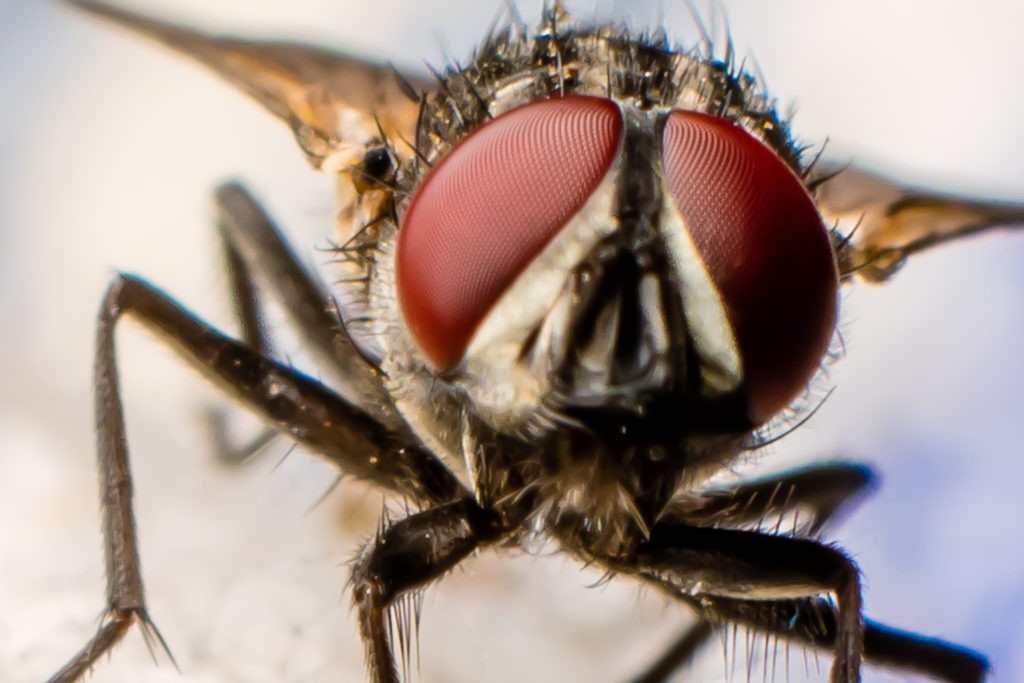
How would the world look from a fly’s point of view? It doesn’t take long to realize that:
1) fly’s eyes look quite different from a human eye
2) fly’s seem to be able to see things they shouldn’t
So, let’s explore the intricacies of the fly point of view.
Structure
There are 4 main distinctions in the structure of a fly’s eye compared to what we are accustomed to:
- No Pupil
- Microvillar Photoreceptors
- Eye Quantity
- Compound Eyes
No Pupil
No pupil exists in a fly’s eye. Without a pupil, there is nothing to control the amount of light entering the eye. This means that each image they see is completely out of focus as we understand it. They cannot choose one thing to focus on in order to add clarity.
Microvillar Photoreceptors
Microvillar photoreceptors are specialized cells in the fly’s retina that respond mechanically to changes in light. This mechanical adjustment is then communicated to the brain electronically instead of the chemical communication that occurs in human eyes. In simple terms, this is much faster and puts fly vision at the top end of vision speed in the animal kingdom.
Eye Quantity
Quantity of eyes in a fly is a total of 5. Two of the eyes are the large ones easily observed at first glance. The three smaller eyes require closer examination. They are typically above the compound eye and only detect light and dark.
Compound Eyes
The large eyes are actually compound eyes. Compound eyes contain small components called ommatidia which are individual light receptors. Each eye can have thousands of these. Each one of these acts as an individual eye with its own nerve connecting back to the optic nerve. Flies receive mass amounts of visual data simultaneously, but cannot move, shift, or focus their eyes for clarity. The best way to understand the function of these compound eyes is to envision a mosaic. These art pieces have many different individual images that combine to give an overall image or effect.
Function
Because of the above eye structure components, eyes have distinct visual functionality from what we know. The following 6 functional differences will illustrate how different the world looks to a fly.
- Sight Speed
- Clairvoyance
- 360 degree vision
- Near sightedness
- Flicker Effect
- Color Blindness
Sight Speed
A fly can perceive light 4 to 5 times faster than a human. Therefore, a fly is 4 times faster at starting the relay of information regarding what it sees in its environment. Any change in motion will be detected as flickers of information that would translate to what we recognize as slow motion. If you could switch your time into slow motion during any type of competition, think of the advantages you would gain! This is why flies are so great at avoiding the death swat.
Clairvoyance
While flies don’t have the ability to time travel or see things that haven’t happened yet, they do have the ability to see into the relative future. Since a fly point of view and subsequent communication processes are so fast, they will find out about something 4-5 times faster than the average human. Since we are talking fractions of a second, it doesn’t sound like much of an advantage, but to a fly, this is the difference between life and death.
360 Degree Vision
A fly point of view is nearly 360 degrees! This means they benefit from the classic parental claim of having eyes in the back of their heads. This immense field of vision would simply confuse us if we suddenly developed this ability. We would experience information overload and be disoriented, but a fly has built in physical reactions to the direction of changes in light.
Near Sightedness
If you have to wear glasses for seeing anything out of arms reach, you may think you can relate to a fly, but it really is far worse for these buzzing insects. In the world of the fly, seeing a few yards away is great vision distance. Their inability to change focus limits their ability to adjust back and forth between far and close. Fast vision of what is occurring within a yard of a fly is where its survival skills lie. Even extremely nearsighted people can enjoy a distant skyline or a beautiful landscape, but not so much for a fly.
Flicker Effect
The flicker effect – As something passes through a fly’s vision, the receptors fire and stop firing. This fly point of view is similar to a scrolling marquis sign that looks like the words are moving, but are actually just changing the firing position. This flicker effect makes flies very sensitive to motion, but weak at identification. They cannot distinguish between something dangerous or not. They simply react to the motion.
Color Blindness
Color blindness – Flies only have 2 kinds of receptor cells which gives them a limited field of color vision. On the other hand, house flies have the ability to distinguish between polarized (light moving in a single plane) and non-polarized light. Polarized light vision is handy every once in a while, but they can distinguish very few colors.
Want to find out how to get rid of flies in your home, restaurant, or other places of business, find out more at https://www.rovepestcontrol.com